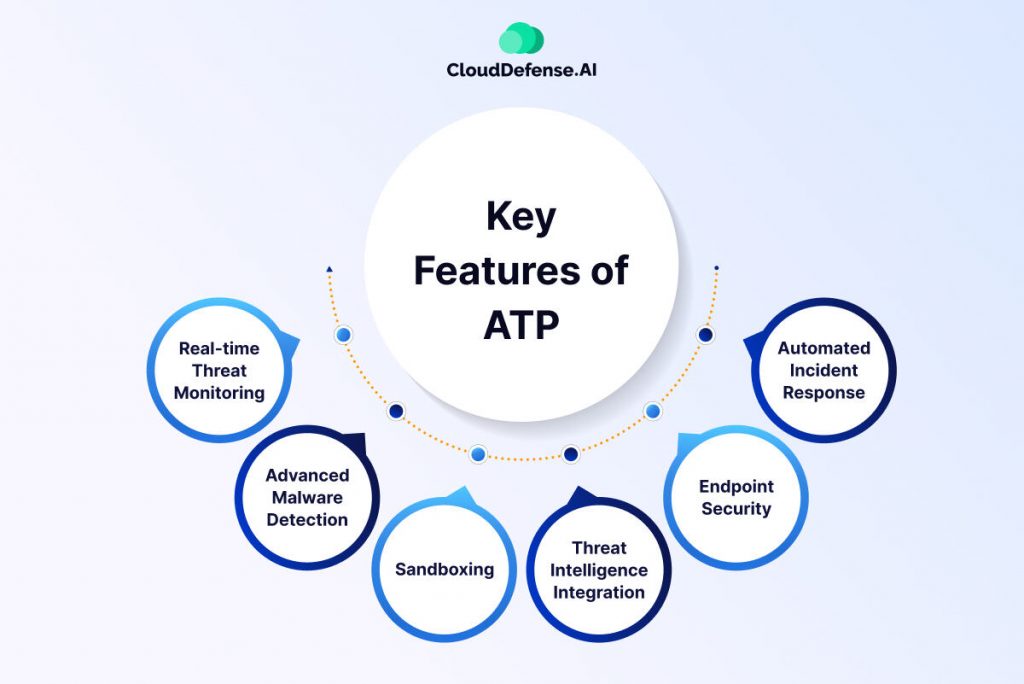Definition — What is Advanced Threat Protection (ATP)?
Advanced Threat Protection (ATP) is a specialized security framework designed to stop highly sophisticated cyberattacks. It goes beyond basic antivirus and firewalls, actively working to detect and block threats before they can disrupt your systems. Think of it as a proactive layer of defense that constantly adapts to new and emerging risks.
Here’s what it brings to the table:
- Identifies Advanced Threats: ATP detects threats that traditional security tools overlook, like zero-day exploits and advanced malware.
- Blocks Threats in Real Time: It stops ransomware, phishing, and fileless attacks before they gain access to your critical systems.
- Automates Responses: When a threat is detected, ATP acts immediately to contain and neutralize it, reducing downtime.
- Monitors Your Environment: Keeps an eye on every endpoint, network, and email channel 24/7 for suspicious behavior.
- Enables Proactive Defense: Helps your team identify potential vulnerabilities and strengthen defenses before they’re exploited.
Usually, the goals of APTs fall into four general categories:
- Cyber Espionage
- eCrime for financial gain
- Intellectual Property Theft for Market Manipulation
- Credential Theft for Access Expansion
- Hacktivism
- Data Theft for Competitive Advantage
- Destruction
- System Manipulation
What Makes a Threat “Advanced”?
An “advanced” threat isn’t just a regular cyberattack. It’s calculated, sophisticated, and designed to bypass traditional defenses. These threats are engineered with precision, often leveraging the latest technologies and exploiting weaknesses that organizations didn’t even realize they had. Here’s what makes them stand out:
Characteristics of Advanced Threats:
- Polymorphic Malware: Constantly changes its code to evade detection by standard antivirus solutions.
- Zero-Day Exploits: Targets vulnerabilities that haven’t been patched or publicly disclosed yet.
- Fileless Attacks: Operates entirely in memory, leaving no trace on disk, which makes detection incredibly challenging.
- Multi-Vector Approach: Uses multiple attack methods (e.g., phishing, malware, and lateral movement) to ensure success.
- Persistent Nature: Maintains access to a system over long periods without triggering alarms, often through backdoors or stealth techniques.
These threats are designed to outsmart traditional tools. They don’t just knock on your door—they figure out how to pick the lock and bypass your security unnoticed. If you’re relying on outdated defenses, you’re playing a losing game. Advanced Threat Protection is specifically built to identify and neutralize these attacks before they can cause harm.
Shortcomings of Legacy Sandboxing Solutions
Legacy sandboxing solutions are outdated, and they just can’t keep up with the speed of today’s cyber threats. The world has changed. Machine learning and automation have made Advanced Threat Protection (ATP) faster and more accurate. Sandboxing is still important, but the old methods have serious flaws. Here’s why they’re not enough anymore:
1. Too Slow with Backhauling:
Legacy sandboxes force data through a central network. This is called backhauling. It’s slow. It ties security to old hardware in data centers. And it’s not built for the remote workforce that most companies have today. You can’t afford delays when you’re dealing with modern threats.
2. TAP Mode Doesn’t Block Threats:
Legacy sandboxes use Terminal Access Point (TAP) mode. They inspect files while they’re traveling, but here’s the problem: they don’t block the threats as they arrive. The alert comes, but by that time, the damage has often been done. It’s simply too late.
3. Encrypted Traffic is a Huge Issue:
Today, most malware is delivered through encrypted channels. Legacy sandboxes can’t inspect this traffic without slowing everything down. You’re talking about a huge bottleneck. And if they do try, they’d need eight times as many appliances to get the processing power to keep up. It’s not feasible.
4. Lack of Scalability:
Legacy sandboxes aren’t built to scale with modern networks. Attacks are becoming more complex and widespread. These systems can’t keep up. They’re stuck in the past. You need a solution that grows with you and handles the demands of the cloud and remote environments.
Why ATP is Crucial?
Can you believe if I say that over the last 21 years, from 2001 to 2021, cybercrime has claimed at least 6.5 million victims with an estimated loss of nearly $26 billion? Cyberattacks have been a constant threat, with an average occurrence every 39 seconds! Yeah, that’s right; the stats say so!
With a staggering 8,000,000 attacks recorded in total, it’s crucial to have strong defenses in place. This is where Advanced Threat Protection (ATP) comes in. ATP is a next-generation security solution that helps organizations stay ahead of cybercriminals and protect their critical data and infrastructure.
Here we will explore what ATP is, how it works, and the benefits it can offer your organization. We’ll also discuss some of the challenges of implementing ATP and how to overcome them. By the end of this post, you’ll have a better understanding of how ATP can help you safeguard your organization from cyberattacks.
Key Features of Advanced Threat Protection (ATP)

Advanced Threat Protection (ATP) is designed to address today’s most complex security challenges. Here’s what sets it apart:
Real-Time Threat Detection
ATP identifies malicious activity the moment it starts, not after the damage is done. It continuously monitors your network, endpoints, and emails, ensuring that no threat goes unnoticed.
Behavioral Analytics
ATP doesn’t just look for known threats—it also detects unusual patterns in user or system behavior that could indicate a breach. This makes it more effective against new, unknown attacks.
AI-Powered Prevention
Using machine learning, ATP can predict and block new types of attacks by analyzing large volumes of data. It adapts over time, constantly improving its detection capabilities.
Automated Incident Response
Once a threat is detected, ATP takes immediate action to contain it—isolating affected systems, blocking malicious traffic, and preventing further damage.
Integrated Threat Intelligence
ATP works with global threat intelligence networks to stay updated on emerging threats. This allows it to recognize and block even the most sophisticated attack methods.
Cross-Layer Protection
ATP operates across all layers of your infrastructure, from the network to endpoints and applications. This ensures that threats can’t move laterally or avoid detection by hopping between systems.
How Does it Work?
We’ve explored the benefits of ATP, but how exactly does it achieve such impressive feats of cyber defense? Let’s delve into the inner workings of this advanced security solution.
At its core, ATP employs a multi-pronged approach that combines sophisticated techniques to identify and thwart threats before they can wreak havoc. Here’s a breakdown of some key methods:
1. Network Traffic Analysis: ATP acts as a vigilant network monitor, constantly analyzing the flow of data across your network. It searches for anomalies and suspicious patterns that might indicate a potential threat.
2. Endpoint Monitoring: ATP’s reach extends beyond the network perimeter. It monitors individual devices (endpoints) like laptops and mobile phones for suspicious behavior. This ensures comprehensive visibility across your entire IT infrastructure.
3. Advanced Analytics: ATP utilizes sophisticated techniques like machine learning and behavioral analysis to identify threats. Machine learning algorithms can detect subtle patterns that might escape human detection, while behavioral analysis helps identify programs or applications exhibiting unusual activity.
4. Sandboxing: For highly suspicious files, ATP employs sandboxes – isolated virtual environments. These act as safe testing grounds where the file can be detonated and analyzed without risking harm to your actual system. This allows for a safe evaluation of potential threats.
5. Threat Intelligence Integration: ATP solutions leverage threat intelligence feeds, constantly updated databases of known threats and vulnerabilities. This empowers ATP to recognize the latest attack methods and respond accordingly.
6. Automated Response: When a threat is detected, ATP can automate pre-defined response actions. This may include quarantining infected devices, blocking malicious URLs, or even isolating compromised systems to prevent the threat from spreading.
By combining these techniques, ATP provides a layered defense that proactively identifies and neutralizes threats before they can cause damage. It acts as a comprehensive security solution that empowers organizations to stay ahead of evolving cyber threats.
ATP offers a powerful shield against modern cyberattacks, but it’s not a standalone solution. A layered security approach is crucial to strengthening your defenses. For that you should:
- Educate your workforce: Equip employees to identify and thwart phishing attempts through regular security awareness training.
- Prioritize patch management: Eliminate vulnerabilities by diligently patching software applications and operating systems.
- Enforce strong passwords and MFA: Implement robust password policies and Multi-Factor Authentication (MFA) to safeguard sensitive systems and data.
- Maintain consistent backups: Regularly back up your data and store it securely offsite to ensure a reliable recovery option in the event of an attack.
What Are the Most Common Advanced Attack Methods?
Cyber threats are growing, and attackers are getting more sophisticated. It’s crucial to understand the advanced attack methods that are out there, so you can better prepare. Here’s a breakdown of the most common ones:
1. Phishing and Spear Phishing:
Phishing is still one of the most common ways attackers gain access to networks. But spear phishing? That’s the next level. These targeted attacks are tailored to specific individuals or organizations. They’re much harder to spot because they look like legitimate emails or messages.
2. Ransomware:
Ransomware is a huge problem. Attackers encrypt a victim’s files and demand a ransom in exchange for the decryption key. It’s becoming more advanced, with attackers now using double extortion methods—threatening to release sensitive data if the victim doesn’t pay.
3. Fileless Malware:
This type of malware doesn’t need to be installed on a device. It operates directly in memory, making it harder to detect. Fileless attacks are hard to block using traditional security tools because they don’t leave any files behind.
4. Advanced Persistent Threats (APT):
APTs are long-term, targeted attacks that aim to remain undetected. These attackers have patience—they infiltrate, monitor, and slowly move through your network over time. Their goal is often espionage or stealing sensitive data.
5. Exploiting Zero-Day Vulnerabilities:
Zero-day vulnerabilities are flaws in software that developers haven’t patched yet. Hackers exploit these vulnerabilities before they’re discovered or fixed. The moment a vulnerability is known, it’s a race to patch it before attackers can use it.
7. Supply Chain Attacks:
Attackers target the software or hardware suppliers you rely on. By compromising a trusted vendor, they can sneak malware into your network. These attacks are difficult to defend against because they’re based on exploiting your trusted relationships.
8. Man-in-the-Middle (MitM) Attacks:
In a MitM attack, the attacker intercepts communication between two parties. They can read, alter, or inject malicious content without the victims knowing. It’s especially dangerous in encrypted communication, where attackers can bypass security and manipulate data in real time.
Conclusion
ATP is more than just a shield; it’s a proactive defense system that hunts down threats before they can wreak havoc in your digital ecosystem. But let’s be honest, even the most powerful guardian needs the right tools. That’s where CloudDefense.AI comes in.
CloudDefense.AI’s unified threat visibility empowers you to spot suspicious activity instantly, while its activity monitoring capabilities detect both known and unknown threats lurking within your cloud workloads. No more wasting time chasing the unknown; CloudDefense.ai prioritizes risks based on your infrastructure, ensuring your most valuable resources are protected first. And if something does slip through the cracks, CloudDefense.AI’s graph-driven investigation tools provide a comprehensive view of the incident, enabling swift remediation.
Don’t wait for a cyberattack to test your defenses. Take a proactive approach to security. Book a free demo with us and see how we can help you achieve comprehensive threat protection and protect your valuable data and infrastructure.







